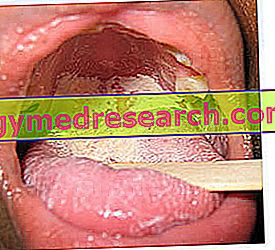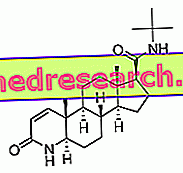Thrush is the most common and characteristic expression of oral candidiasis, an infectious disease of the buccal mucosa supported by yeasts belonging to the genus Candida . Among these, the most common causative agent in humans is Candida albicans, the same responsible for vaginal candidiasis.

Causes
The thrush affects mainly newborns, but also prefers elderly and immunocompromised adults, so much so that the finding of oral candidiasis in a young adult not affected by neoplasia, nor in treatment with cortisone, must always lead to suspect an underlying HIV infection.
Candida is an integral part of the flora present in the oral cavity of many people; only when the host's immune defenses precipitate, this micro-organism can proliferate almost undisturbed inside the mouth, causing the infection known as oral candidiasis, of which the thrush (or acute pseudomembranous candidiasis) is the most characteristic manifestation.
As for the neonatal period, thrush mainly affects newborns born to mothers with vaginal candidiasis, especially if they are premature; also in this case the infection is more common in dystrophic infants.
Risk factors
Prolonged antibiotic treatments can cause the onset of thrush, as they tend to reduce the symbiotic (beneficial) and saprophytic bacterial flora that controls the growth of Candida albicans .
Diabetes, smoking, the presence of conditions that induce xerostomia (dry mouth), and the use of dental prostheses, complete the picture of risk factors for this annoying and generally not serious infection.
Symptoms
The lily of the valley is characterized by the appearance of whitish, milky plates (they look like stale milk), point-like, lenticular or confluent; the commonly affected sites are the back of the tongue and less often the palate, while the extension in the back mouth, in the esophagus and in the larynx is the indicator of an important depression of the immune system (AIDS, lymphomas, neoplasms, drug addiction, prolonged therapy with corticosteroids and chemotherapy)
The lily of the valley can cause an intense burning, for which it is difficult to feed and the flavors are not perceived; when the infection is also extended into the throat and esophagus, the patient complains of difficulty swallowing and may be feverish.
The infant tends to manifest the discomfort induced by the thrush through crying and nervousness, while when the infection is transmitted from the mouth of the baby to the mother's breast, the latter complains of symptoms such as reddened nipples, particularly sensitive or painful.
The greyish-white islets present in the oral mucosa of people suffering from thrush, are essentially constituted by epithelial cells, leukocytes and agglomerates of the fungus; once detached, they show an erythematous, abraded and easily bleeding surface below.
Photo Lily of the valley

See other Photos Lily of the valley
Care
The treatment of thrush obviously depends on the extent of the infection and its manifestations; in milder forms, special mouthwashes or rinses can be used with alkaline solutions (sodium bicarbonate, sodium borate) or hydrogen peroxide (hydrogen peroxide) at 3%.
If the thrush affects a breast-fed baby, the applications must also be extended to the nipple and the areola of the mother; in similar situations (for which the use of antifungals is not normally indicated, unless the infection is resolved within two weeks), it is equally important to sterilize teats and pacifiers before use.
drugs
If oral candidiasis occurs after the use of antibiotics, the doctor may recommend the use of unsweetened yogurt or even better probiotic preparations. In the most widespread forms, on the other hand, the treatment of thrush includes the use of candida active drugs, such as nystatin, miconazole and clotrimazole.
In the event that the infection is also extended to other sites of the body (esophagus, heart, brain, eyes, genital areas, joints), and in immunocompromised patients, more powerful drugs can be used, such as fluconazole, ketoconazole and amphotericin B.
To learn more, read: Medicines for the treatment of lily of the valley »
Prevention
The most important prophylactic measure consists in not modifying the balance of the local bacterial flora (advice valid especially in the prevention of vaginal candidiasis) and in following a healthy lifestyle that maintains the host's humoral (immune) defenses very efficient.
The prevention of type II diabetes - through healthy eating, body weight control and regular physical activity - also translates into an effective prophylactic work against the thrush. The growth of oral candida is in fact favored by the presence of abundant amounts of sugar in the saliva, which contains glucose in concentrations similar to those of the blood.
To learn more, read: Diet and Candida and Strengthen the immune system "



